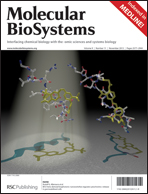Assessment of crosstalks between the Snf1 kinase complex and sphingolipid metabolism in S. cerevisiae via systems biology approaches†
Abstract
Sphingolipids are essential building blocks of the plasma membranes and are highly bioactive in the regulation of diverse cellular functions and pathological processes, a fact which renders the sphingolipid metabolism an important research area. In this study, a computational framework was recruited for the reconstruction of a functional interaction network for sphingolipid metabolism in Baker's yeast, SSN. Gene Ontology (GO) annotations were integrated with functional interaction data of the BIOGRID database and the reconstructed protein interaction network was subjected to topological and descriptive analyses. SSN was of a scale-free nature, following a power law model with γ = 1.41. Prominent processes of SSN revealed that the reconstructed network encapsulated the involvement of sphingolipid metabolism in vital cellular processes such as energy homeostasis, cell growth and/or death and synthesis of building blocks. To investigate the potential of SSN for predicting signal transduction pathways regulating and/or being regulated by sphingolipid biosynthesis in yeast, a case study involving the S. cerevisiae counterpart of AMP-activated protein kinase, the Snf1 kinase complex, was conducted. The mutant strain lacking the catalytic α subunit, snf1Δ/snf1Δ, had elevated inositol phosphorylceramide and mannosyl-inositol phosphorylceramide levels, and decreased mannosyl-diinositol phosphorylceramide levels compared to the wild type strain, revealing that Snf1p has a regulatory role in the sphingolipid metabolism. Transcriptome data belonging to that strain available in the literature were mapped onto SSN and the correlated SSN was further investigated to evaluate the possible crosstalk machineries where sphingolipids and Snf1p function in coordination, in other words the crosstalk points between sphingolipid-mediated and Snf1 kinase signalling. The subsequent investigation of the discovered candidate crosstalk processes by performing sensitivity experiments imply a tight interconnection between sphingolipids and Snf1p in the regulation of calcineurin activity, cellular metal ion homeostasis and response to cell wall and endoplasmic reticulum stresses in yeast.


 Please wait while we load your content...
Please wait while we load your content...